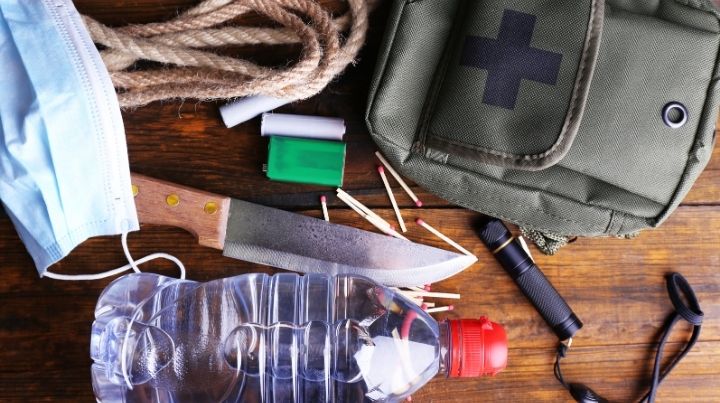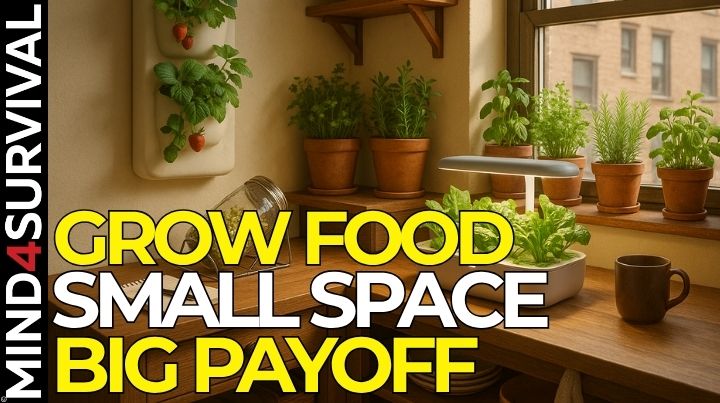What’s in Your Get Home Bag?

An essential part of preparedness that is often neglected is the get-home bag. Unlike a bug-out bag, your get-home bag (also known as an escape and evasion bag) is generally kept in your vehicle and is typically smaller than a bug-out bag you might have at home.
The purpose of your get-home bag (GHB) is to get you home from work or somewhere else in case of an emergency. The goal of this article is to help you choose what you might need in your GHB.
I reside in New England, so I use one bag for Fall/Winter and one for the Summer months. This article will focus on items that I use in both bags regardless of the season. I believe all a get-home bag must be unique to the individual. Someone in an urban area will have different needs from someone in a rural area.
When making a get-home bag for you and your family members, you should do a thorough threat assessment and then make up their bag specific to your threats, strengths, and weaknesses.
Part of your planning should involve looking at egress routes from where you work. Are there high crime areas nearby? Do you cross a bridge to get to work? If the interstate is blocked or shut down, how will you get home?
Remember, you might be on foot and have to go through a rough area. This should all be part of your planning.
Get Home Bag Size
After doing your threat assessment, it’s time to figure out what size bag will be best for you. I prefer a small to medium-sized bag with good shoulder straps — the bigger the bag, the more gear you will want to pack in it.
As a former soldier and avid hiker, I have watched this occur numerous times. So always factor in weight and plan accordingly. It is no use having a bunch of gear you don’t need slowing you down when the goal of a get-home bag is to get you home safely.
I recommend looking for a good quality bag from a reputable manufacturer. Well, that is, look for a good quality bag if you value your and your family’s lives as much as I do.
Food and Water for Your Get Home Bag
Water is a must for any situation. I tend to use both a water bottle and a larger water bladder. I believe that you can never have enough water because dehydration is no joke and can quickly kill even the most experienced preppers. Back up your water supply with a filtration device like a Sawyer Mini if there are water sources you can purify along your route.
For food, I keep protein bars and other snacks in my bag and rotate in fresh food regularly or as I eat my current bars. I also keep two Mountain House meals in my bag, which have a long shelf life and taste great.
It’s good to remember that the Mountain House meals do require water. (Remember I said you can never have enough water?) I do not advise people to eat them dry. When it comes to food, in my opinion, lighter and longer-lasting is the best way to go.
Get Home Bag Knife
A good fixed blade knife is also a must, in my opinion. Knives tend to be a very debatable subject amongst people as a whole, and even more so within the prepper community. I recommend a full tang knife for the added strength.
In case you aren’t aware, according to Turley Knives, “A full tang is a knife that has a visible tang (the steel under the handle) when viewed from the top or bottom, and the handles are made up of two pieces of material, one on each side.”
For length, I prefer a six or seven-inch knife, which I find to be just right for defensive situations or fieldcraft. With knives, you get what you pay for. However, even a prepper on a tight budget can still find a good quality knife from a reputable manufacturer.
I recommend avoiding daggers as they tend to break very easily. A sawtooth blade is, in my opinion, also a waste of money. If you think otherwise, try cutting a branch with one and see what you think. I always find that you can chop through a branch a hell of a lot faster than you can saw through one.
The reality is those saw teeth were initially put on knives for aircrews to cut their way out of a crashed aircraft. I say, leave the saw teeth for the action films and focus on what is efficient, reliable, and adds to your capabilities. In the end, choosing a knife is a very personal choice. So, do your research on what suits your unique needs and budget best.
Get Home Bag Firearm
As with knives, guns are continually the cause for debate within the preparedness world. Because of that debate, I’ll keep it simple; choose a weapon that is, first and foremost, reliable.
While some people might feel they want a specific caliber or style of gun, what is most important is their ability to handle it safely and correctly. As with knives, a firearm is a very personal choice that is unique to each person. It’s good to remember that a gun does not need to be expensive to be reliable. So, make sure you do your research before investing your hard-earned money into a new gun. Regardless of which handgun I carry, I do so with one or two extra magazines.
For those of you who live in less than firearms-friendly areas, you may want to consider alternative choices for your defensive needs. However, before you do, check your local laws to not end up on the wrong side of law enforcement.
One aspect of firearms that is not unique to each person is our responsibility to safely and properly use firearms if we choose to carry them. So, don’t just go out and purchase a gun without learning how to use it.
Get Home Bag Miscellaneous Items
These various final items round out the essentials for my escape and evasion bag.
- I keep one Mylar blanket in my vehicle and my desk at work. They are cheap, so I buy extra ones to keep on hand for emergencies.
- Next, I believe that everyone needs a compass. I like the military type, but the truth is that any compass is better than nothing at all. While Smart Phones and GPS units are great, only a fool would bet their life on one during an emergency.
- Another item I carry is a torch-style lighter, which is what I prefer to make a fire with when it’s needed. Following the “two is one, one is none” mindset, I also keep a few extra disposable lighters in my bag to not be caught without a source of fire and heat.
- Lastly, I make sure to pack a windbreaker. They’re great, and I like them because they don’t take up much room and, depending upon the brand, are a very versatile addition to your E&E bag.
You may have some other essentials like medications or items specific to your environment.
The Bottom Line on Get-Home Bags
It’s good to remember what I mentioned earlier when setting up your get-home bag. Before doing so, make sure that you take the time to research and tailor your bag for your needs and geographic area.
Remember, the get-home bag is meant to get you home. It’s not intended for long-term survival situations.
While it may seem like a daunting task to put one together, especially for the first time, it’s not. The reality is that putting together your get-home bag is straightforward, affordable, and may one day save your life.
What is in your get-home bag? How is it different from your bug-out bag? Let's talk about get-home bags in the comments.
Related Articles
FREE Guide
Read the Best Seller
Join Mind4Survival
Stay informed by joining the Mind4Survival! 100% Secure! 0% Spam!
Affiliate Disclosure...
Mind4Survival is a free, reader-supported information resource. If you make a purchase through our link, we may, at no cost to you, receive an affiliate commission.
Do You Want To Be Ready No Matter What?

Download our free 39-page guide with interactive, 7-Day Emergency Kit Checklist and take the first step toward real preparedness.
- Know exactly where to start.
- Save time and money.
- How-to build a complete Basic Emergency Kit.
- Level up your safety and security.
Join Mind4Survival
Stay informed by joining the Mind4Survival! 100% Secure! 0% Spam!






What a great article and definitely a push to assemble one of these bags. Even as an older person it’s a great idea that a lot of us don’t think about doing. Great article and well written.
Thanks for the great feedback Patricia! Keep us posted on your E&E bag progress.
Great article, Brian. I’m going to add some moleskin and a pair of wool socks. If I have to walk far, I want to be sure to protect against blisters. Getting blisters is bad enough, but I’m currently a chemotherapy patient. Chemo lowers body defenses so a minor injury like an open blister can become a really serious issue for me in short order.
Milan, have you tried the moleskin and wool socks yet?
I would suggest some backup cash in an E&E urban situation it might buy you out of a tight situation or help create a distraction if necessary.
I also keep insulation tape and a metre or two of thin rope.
Its great to stress the weight issue. Most people do not understand how quickly a bag will become heavy if you are having to walk any type of long term distance. Its not like the movies if an individual has not trained nor checked the weight of their bags they are in for a rude awakening. Great content as usual.
Thanks, Michael!
Stay safe!
Brian
Very well written, I am currently updating my “get home bag” as I now work in violent city and have 28 miles to get home. I am considering a folding bike that I can lock in the car. Your thoughts would be great. I have a hybrid mountain bike but that is not small and locking it on the outside of my care is only an invitation to theft. I want to stay the grey man if possible.
Thank you again.